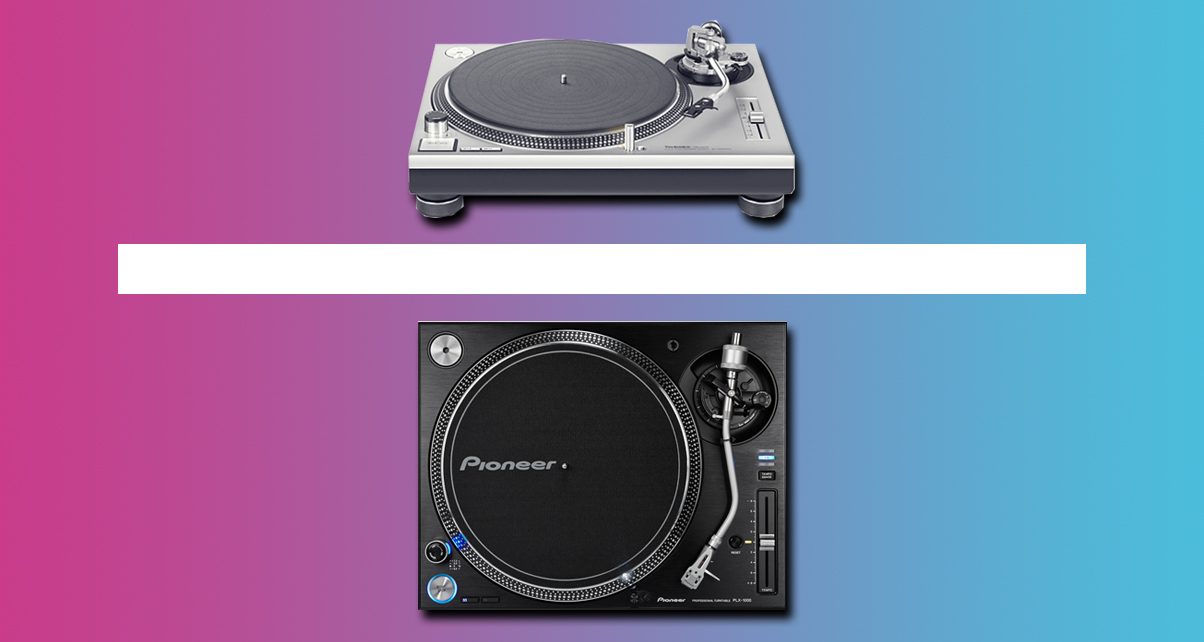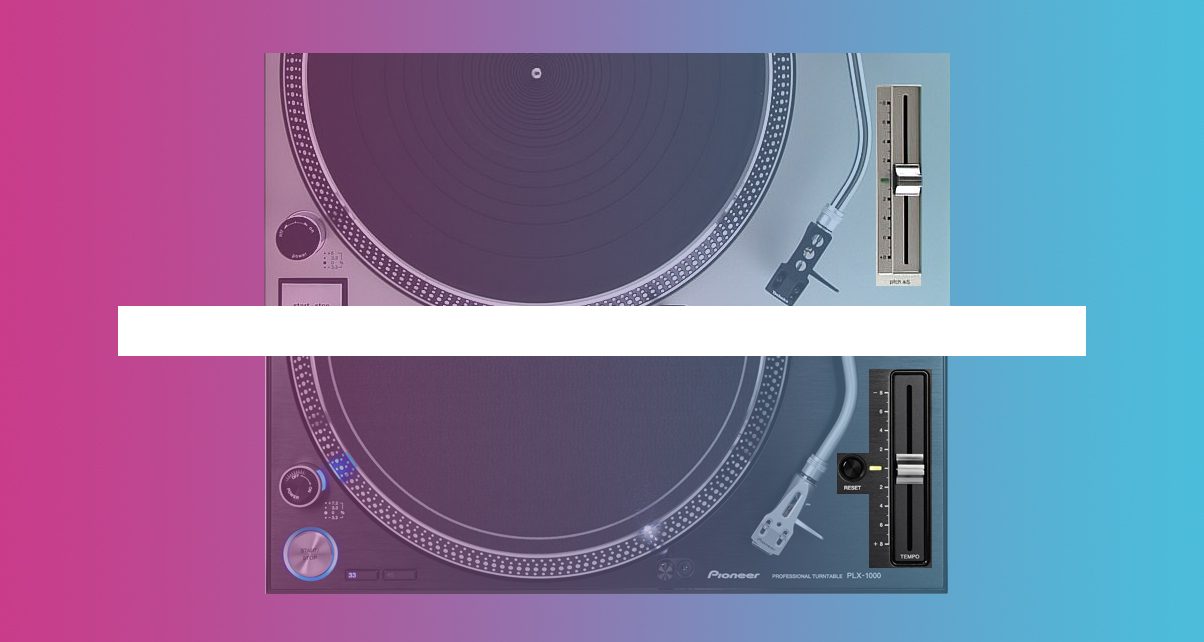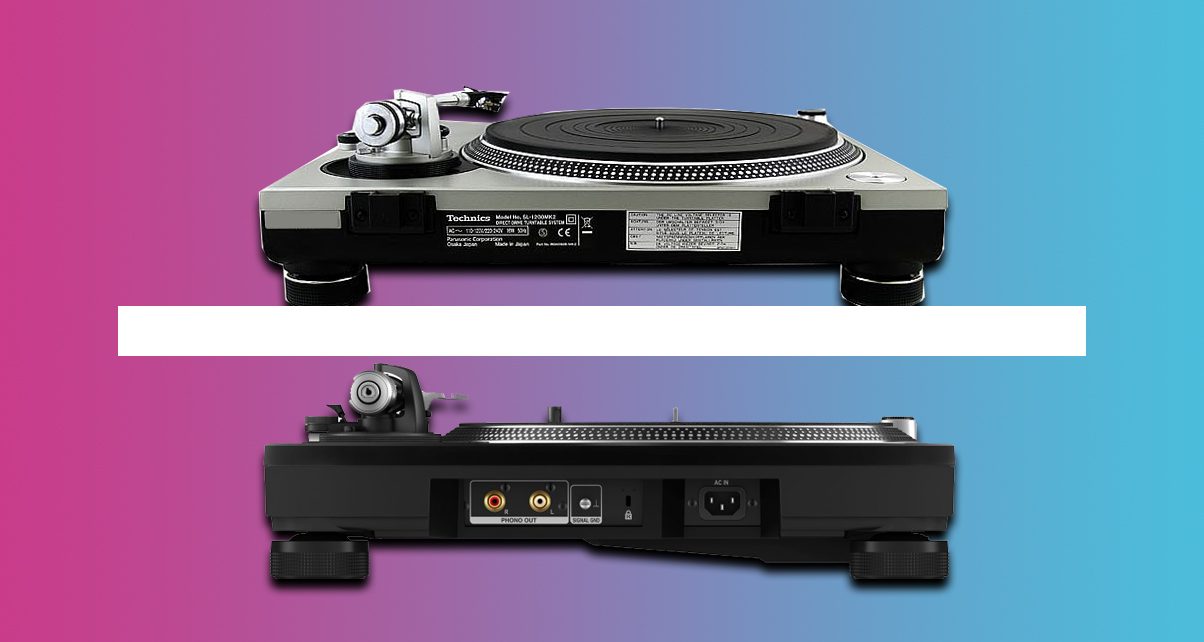There has been renewed interest in vinyl recently: festivals and clubs put on vinyl-only DJ sets, DJ manufacturers have been releasing DVS equipment, and the niche portablism scene continues to grow. All of these coupled with annual DJ battles like the DMC Championships, Red Bull Thre3style, and A-Trak’s Goldie Awards have made turntables relatively visible once again, even in mainstream DJing.
Thus, you may have been toying with the idea of incorporating turntables in your digital DJ set-up, or maybe you’re thinking of upgrading your beginner decks to more industry-grade kit. If you’re looking for a solid pair of turntables that you can rely on whether you’re DJing at home or taking them to gigs, you’ve no doubt come across Pioneer DJ’s PLX-1000. How does it stack up against the industry-standard Technics 1200 MK2? We find out in this head to head…
Head To Head:
1. Size and build
 Technics 1200 MK2: 453 x 360 x 162mm, 14kg
Technics 1200 MK2: 453 x 360 x 162mm, 14kg
Pioneer DJ PLX-1000: 453 x 353 x 159mm, 14.6kg
The turntables have almost identical dimensions and weight, and that’s no surprise: it’s no secret that the Pioneer DJ PLX-1000 is inspired by the Technics 1200 MK2. The PLX-1000 is slightly heavier, and this is a good thing: that makes it less susceptible to bumps, thumps and bass vibrations that could cause the needle to skip.
That said, both models are made of metal, each has a die-cast chassis and they’re are built like tanks. DJ turntables don’t get any more solid than these two.
2. Price
Technics 1200 MK2: From US$400 used each, depending on the condition
Pioneer DJ PLX-1000: US$699 each
Generally, more expensive DJ turntables mean that they’re built with better materials, and you do get what you pay for. A brand new PLX-1000 pair will set you back just under US$1400 – add in a top shelf scratch mixer like the DJM-S9 (US$1999), and you’re looking at a rather expensive set-up, but you do get all the bells and whistles that you’ve come to expect with digital DJing: DVS control via Serato DJ or Rekordbox DJ, performance pads, next-generation effects and effects control, and so on.
If you’re on a tighter budget, a pair of used Technics 1200 MK2s will set you back under US$1000. Technics stopped producing this iconic model back in 2010, so most of the decks that you find will be used or will be from deadstock resellers (By the way, if you’re confused as to the difference between SL1200s and SL1210s, the 1200s are the silver model and the 1210s the gun metal option – nothing more).
(Technics recently resumed production for its brand new 1200G (US$4000) and 1200GR (US$1699) models, but these are intended primarily for the pro audio market and are priced out of reach for most DJs.)
If you decide to get a pair of used Technics 1200 MK2s, that gives you more wiggle room to add in a mixer of your choice, whether you want a high-end model like the DJM-S9, or entry-level / mid-tier options like the Pioneer DJ DJM-250Mk2 and Pioneer DJ DJM-450. These mixers still give you DVS connectivity but at a fraction of the cost.
3. Pitch fader
 Technics 1200 MK2: +/- 8%
Technics 1200 MK2: +/- 8%
Pioneer DJ PLX-1000: +/- 8%, +/- 16%, +/- 50%, reset button
The standard Technics 1200 MK2 pitch fader gives you a pitch range of +/- 8% of your song’s tempo. This is enough for common beatmatching – if you’re spinning actual vinyl without the benefit of digital pitch correction, throwing the pitch fader to either maximum will make the tune sound strange anyway (slowing it down a lot will make a track sound “low”, and speeding it up will give it the “chipmunk” treatment).
The Pioneer DJ PLX-1000 has additional pitch fader ranges: +/- 16%, +/- 50%. This allows for some more extreme tempo adjustments, and while it would also sound strange if you were spinning actual records, this could come in handy when you’re using DVS and timecode vinyl, since you can “lock” the musical key of a song when you’re spinning with DJ software like Serato DJ, Rekordbox DJ, Virtual DJ, or Traktor Pro.
The Pioneer DJ PLX-1000 has an edge here because of its selectable tempo ranges, plus it also has a “Reset” button that cancels out any pitch adjustment that you’ve made, and sets the spinning platter back to its default speed. This is handy for quick tempo changes where you just want to go “back to zero”.
4. Tonearm and headshell
Technics 1200 MK2: S-shaped tonearm, Technics standard headshell
Pioneer DJ PLX-1000: S-shaped tonearm, Technics-style headshell
The Technics 1200 MK2 and Pioneer DJ PLX-1000 have similar controls for tonearm height and anti-skate, a tonearm lever for lifting the arm, and an adjustable tonearm weight. The tonearm on the PLX-1000 is also recessed, just like the Technics 1200 MK2.
The headshells of both units use the same four-pin connector. You can use any Technics-style headshell and stylus for both turntables, or Ortofon Concorde stylii. You can screw on additional weights to the PLX-1000’s headshell, kind of like how DJs would stick a coin on top of a Technics headshell back in the day.
5. Audio and power leads
 Technics 1200 MK2: 2x wired RCA leads, 1x wired power cable
Technics 1200 MK2: 2x wired RCA leads, 1x wired power cable
Pioneer DJ PLX-1000: 2x detachable RCA leads, 1x detachable three-prong power cable
RCA output leads and power cables are common replacements in ageing Technics 1200s, and if you pick up a used pair, it’s likely that they’ve already been changed. This isn’t an issue, as long as the replacements are good quality. If you want to change the leads yourself, they do require soldering, which could mean sending it to a repair shop if you aren’t handy with a soldering iron.
Pioneer DJ made swapping cables easier on the PLX-1000 by having RCA and power sockets – you can use any RCA leads or three-prong power cable (also called an IEC cable) with it. If a cable fails, just change it.
6. Platter speeds and torque
Technics 1200 MK2: 33 1/3RPM and 45RPM, 0.7 seconds platter start time, 1.5 kgf torque
Pioneer DJ PLX-1000: 33 1/3 RPM and 45RPM, 0.3 seconds platter start time, 4.5 kgf torque
Both the Technics 1200 and the Pioneer DJ PLX-1000 have the same platter RPM speeds: 33 1/3RPM and 45RPM. Having both of these speeds means you’re practically covered for playing back both timecode vinyl and analogue vinyl moving as far back as the mid-20th century.
The Pioneer DJ PLX-1000 has a slightly stronger motor, pushing the platter to full speed fractions of a second less than the Technics 1200. This is a good thing for DJing because this lets the platter quickly “catch up” when you put your hand on the record (like when you’re scratching) or when you make adjustments to the pitch fader. This leads to more accurate pitch bends, and shorter lag in between a record spinning at full speed when you let go of it after a scratch.
Finally…
Overall, price will be a major factor in determining which one to go for, as well as the condition that you’d want to get your turntable in. Obviously Pioneer DJ has an edge in “newness”, but Technics are so well-built that even models from the 80s and 90s are still usable (you can find the year a deck was made by looking for the serial number at the back of the turntable and doing an online search). If you find a pair of old Technics that are in need of a bit of love, they can be serviced fairly easily – replacement parts are widely available, both online and in record shops.
Both the Technics 1200 MK2 and the Pioneer DJ PLX-1000 are fairly “traditional” as far as turntables go: all they do is connect to the phono input of your mixer or DJ controller and play back your vinyl. Some modern turntables do so much more: the Reloop RP-8000, for instance, has a USB connection and Midi-mappable buttons onboard, while the Denon DJ VL12 Prime has adjustable platter torque.
If you’d like to own a pair of brand new turntables and have the budget for it, go with the Pioneer DJ PLX-1000. If you don’t mind buying used, would like to save a couple of hundred dollars, and want “the original”, go for the Technics 1200 MK2s.
Have you spun on both the Technics 1200 MK2s and the Pioneer DJ PLX-1000? Which one do you prefer? Share your thoughts below.




